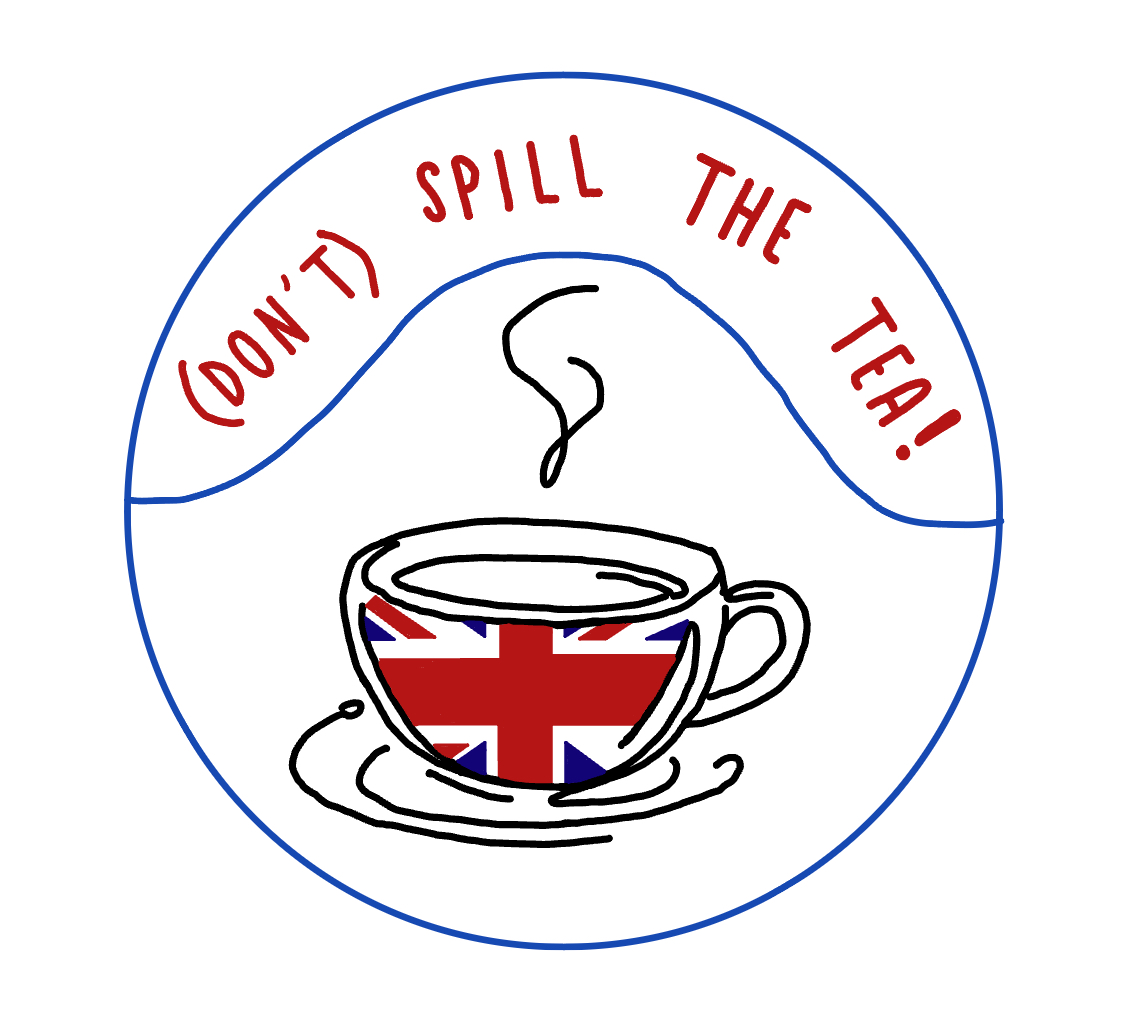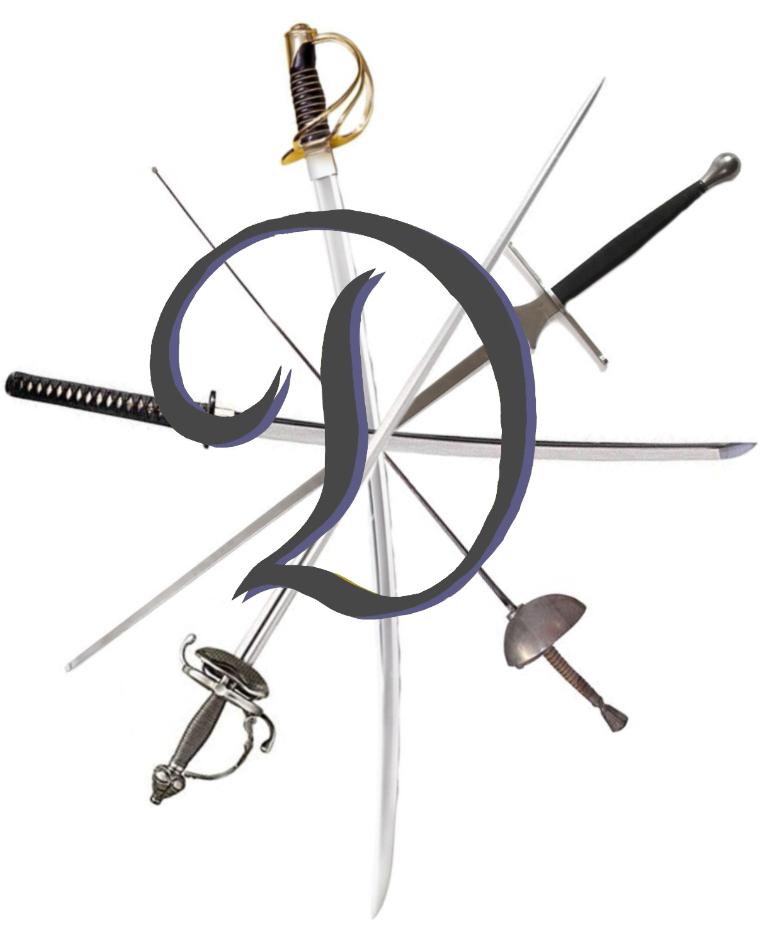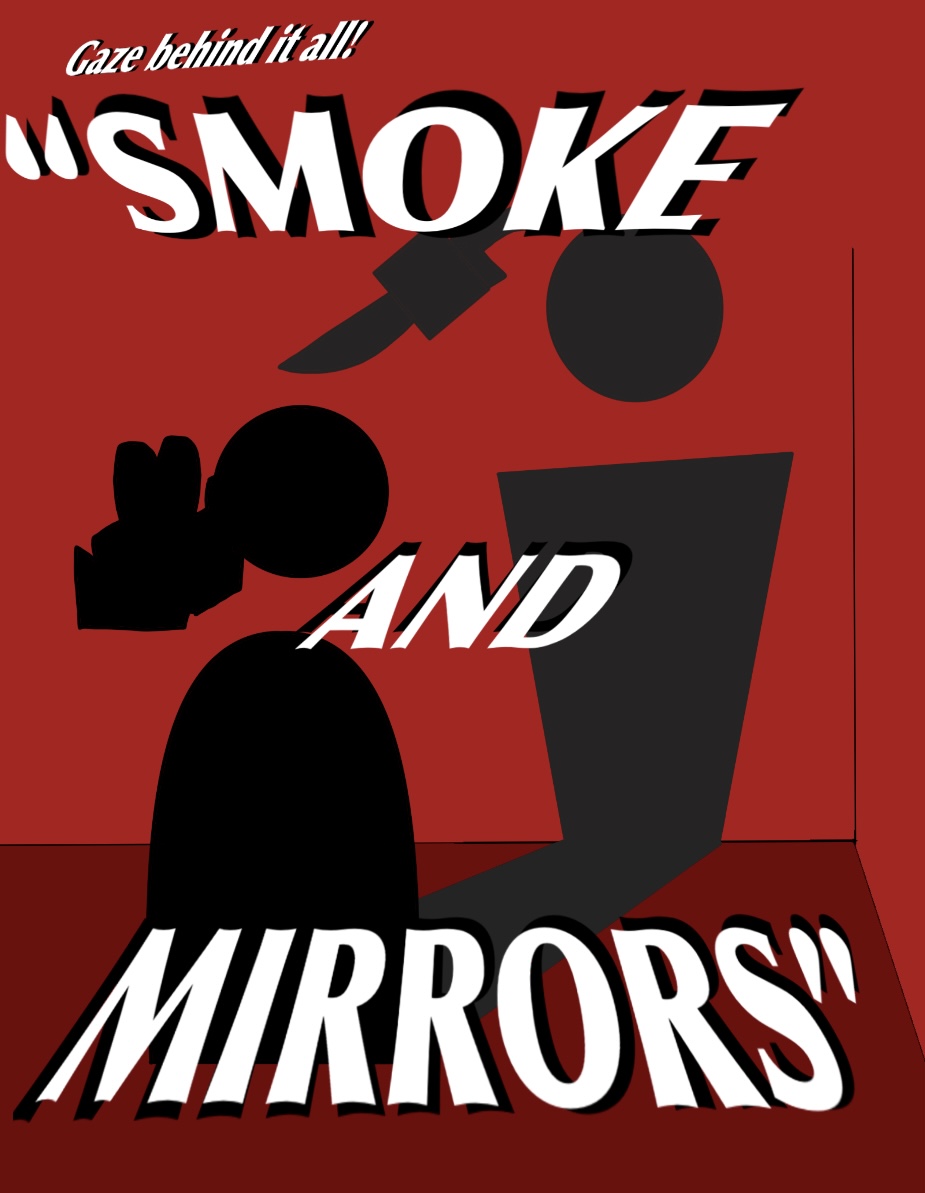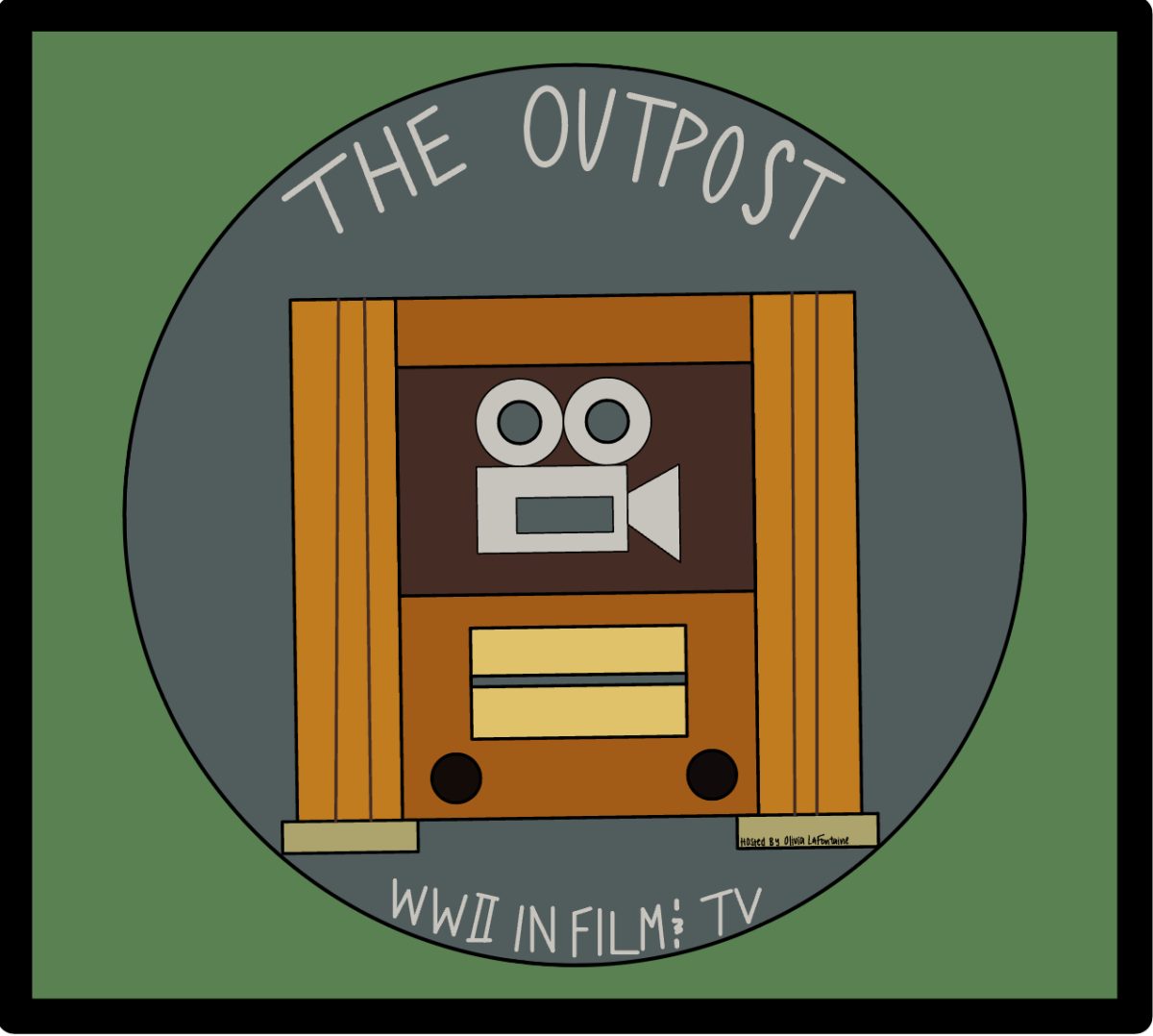Welcome!
Hello and welcome to (Don’t) Spill The Tea!, my name is Grace. Both of my parents grew up in England and they moved to the US not long before I was born. Having British parents, I was regularly exposed to staples of the British diet, such as tea, while I was growing up. In this blog, I hope to have a fun discussion about this topic and bring light to more than just the stereotypical foods people think of when they think of British cuisine. Never fear, though, the classics will of course be discussed as well. So, if you’re interested in diving beyond the fish and chips and beans on toast, join me here on (Don’t) Spill The Tea! and let’s have some fun!
May 9th, 2025: So, You Want To Have A Tea Party?
The first, and arguably most important, staple of British food culture is tea. We’re not talking about herbal teas or Earl Grey, but the classic black tea found in households across England. Brits drink tea—usually more than one cup a day, at that. But what are the nuances of the art of making and consuming tea that may escape the notice of those of us less familiar with the tradition?
Well, the making of the tea is simple. You put the tea—usually in the form of tea bags—into a mug and pour in boiling water from a kettle. Do not, under any circumstances, ever, use a microwave to heat your water, you may just be banned from ever entering the UK. Then, let it brew for about 5 minutes, and—boom—you have tea. It is important to note that many Brits would also argue the only true way to make tea is with tea leaves and using a teapot, but I digress.
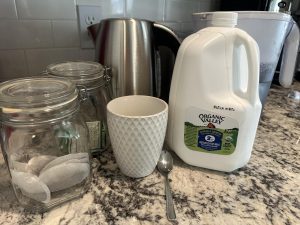
But what do you put in the tea? Do you want sugar or not? Will you have it with milk or not? Most Brits will have their tea with milk, and some add sugar (or, more commonly, a form of artificial sweetener). Then, there’s the question of what you’ll have with your tea. Will you just drink the tea, or will you have a biscuit (a cookie, for us Americans) with it too?
Another thing to consider is the idea of afternoon tea. In true British fashion, afternoon tea takes tea and makes an entire event out of it. Complete with little sandwiches, pastries, and scones, afternoon tea is perhaps the most fun way to consume tea. Also in true British fashion, afternoon tea comes with some controversy.
Alright, if we’re being honest, this controversy is not really about the afternoon tea, but about the scones. When you sit down to tea, your scones will be served with jam and clotted cream (a thick cream somewhere between whipped cream and butter). But when you put these spreads on your scone, which will you put on first? There’s the Devon way—cream first, then jam—and the Cornwall way— jam first, then cream. While this may seem like an innocent question, it is an enormous source of debate amongst the British public. I myself am in the “Devon way” camp.
My mother—who may just disown me for saying that—does not agree. She is staunchly on the “Cornwall way” side of the debate. So if you ever find yourself out to tea with a Brit, tread carefully and stay safe, this kind of thing could just end friendships and break up families.
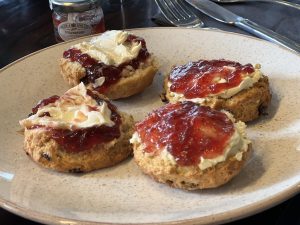
So, now you know. Next time you want some tea, think about embracing your inner Brit and having it the proper way. It’s not difficult, but it is vital to British culture.
May 15th, 2025: The Classics: Stereotypes vs Reality
The thing about stereotypes is that, usually, they come about for a reason. British cuisine is no different. In order to compare the stereotypes and the realities, I must first admit that most of the stereotypes are, in fact, realities. Brits do eat beans on toast, fish and chips is a popular dish on menus in pubs across England, and as previously mentioned, people in England do drink a lot of tea. So I suppose this post is less about breaking stereotypes, and more about going beyond them.
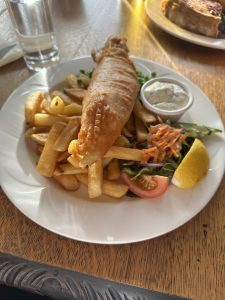
Like I said, fish and chips is a very popular dish. You really can’t go wrong with some fish that has been covered in batter and fried, served with chips—chips are basically French fries, but usually they are cut into thicker chunks—and some other small side, like mushy peas, for example. Mushy peas are exactly what they sound like—peas that have been cooked and then mashed until they become, as the name suggests, mushy. Mushy peas are not my personal favorite (spelled favourite, for the Brits out there), but a lot of Brits like them—or so I’m told.
Another staple, beans on toast, needs little explanation. You take beans, you take toast, you put them together and there you have it. No one will ever accuse the Brits of having an overly complicated palate, that’s for sure. But, it works, and as they say, if it ain’t broke, don’t fix it.
Now it’s time to talk about the less stereotypical classics. The Sunday roasts and the full English breakfasts. These are things that are lesser-known to those of us outside the British inner circle, but that any true Brit would know easily. These two only begin to scratch the surface of classic British cuisine, but they are a good place to start.
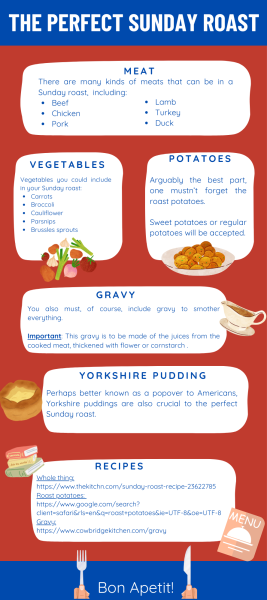
Let’s start with my personal favorite, the Sunday roast. As the name suggests, this meal is usually consumed on a Sunday. It has all the necessary elements—protein, veggies, and gravy—and really encapsulates the British diet. The main part of the dish is the roast meat, usually beef, chicken, pork, or lamb. Then there’s the roast veggies like carrots, broccoli, and Brussels sprouts. And, in my humble opinion, the most important part of the whole roast, the roast potatoes. I could make a whole new post about these glorious morsels of joy, but I’ll spare you that and just say this: roast potatoes are crucial to the perfect Sunday roast. All this will be served with a healthy portion of gravy and a side of a Yorkshire pudding. Yorkshire puddings are liars. They are not puddings, they aren’t even sweet. Think of a popover and that is what a Yorkshire pudding is like. Put all these together and there you have a Sunday roast that would make any Brit proud.
And finally, there’s a full English breakfast. If you ever find yourself in England, you’ll probably encounter this classic at some point. To do it properly, you’ll need to fill your plate with many different things. Starting on the simpler side, you’ll need eggs (scrambled, poached, or fried), bacon, and sausages. Then there’s toast, baked beans—we mustn’t forget the idea of beans on toast—tomatoes, and mushrooms. Then there’s the black pudding. Like the Yorkshire pudding, it too is a liar. Black puddings cannot be mistaken for sweet desserts. They are blood sausages, made with animal blood and ingredients like oats and barley, and mixed with spices. To me, this is not an inviting concept and so I will not torture myself, or you, with any further description. To finish off your perfect full English breakfast, you will need a drink. Something like coffee, or, of course, tea.
These are just a few of the many classic dishes one will find in England. The Brits might not be the most creative chefs in the world, but they certainly know what they like and how to make many different dishes from it.
May 22nd, 2025: And For Those Of Us With A Sweet Tooth…
We simply couldn’t discuss British cuisine without talking about sweets—or candy, as it may be better known—and puddings (aka desserts).

In my opinion, British candy is better than its American counterpart. Especially—and undeniably—the chocolate. With choices like Cadbury and Galaxy, England really does know how to do chocolate. Every time I visit, I come home with a lot of chocolate stuffed in my suitcase. I’d buy a whole new suitcase just to fill with chocolate, but my parents say that’s too much. What do they know, right? (Right?)

Okay, so I might have a chocolate problem—what of it? I can talk about other things. Here, let’s talk about other candy. England also does gummy candy really well. My personal favorite hails from the classic British establishment Marks & Spencer. The gummies are called “Percy Pigs”, and their mascot, Percy, is basically a national treasure. They’re small, pig shaped, pink candies with strawberry, raspberry, and cherry flavoring. They’re also—fun fact—vegetarian. You may even see Percy Pigs making their way to the US, if the rumors are to be believed. Gummy candies in England also include classics such as Rowntree’s Fruit Pastilles and Randoms, both variations on small, sugary, gummies that provide a burst of fruity flavor.
The Brits don’t just eat candy, they also love a good pudding—or dessert. There are, of course, many classic British puddings, such as Treacle Tart and Sticky Toffee Pudding. I could spend all day talking over the dessert menu at any given restaurant in England, but I won’t do that. Instead, I will just share a few of the dishes I know most about.
A British pudding can be a lot of things. From the summery delight of Strawberries and cream, to the Christmas classic of trifle, the British definition of pudding is wide. A trifle is a classic British dessert that you may not have heard of. It is made with layers of cake, custard, berry jam, and whipped cream. Classically served at Christmas time, the flavors can also be adapted to fit any time of year.
Another classic —and a favorite of mine—is Banoffee Pie. This treat consists of a biscuit base topped with fresh banana slices, covered in a toffee layer that is then allowed to set in the fridge, and then topped with whipped cream and more banana slices. If you don’t like bananas, you may want to steer clear—but maybe give this classic a shot, it could surprise you.
As you can see, the Brits sure do have a sweet tooth. This is perhaps where you will see the most creativity in British cuisine. Most meals at restaurants will be accompanied by a pudding—or at least the option to order one. Should you find yourself in the UK any time soon, find a dessert menu and try something new, I’m sure you won’t regret it.

